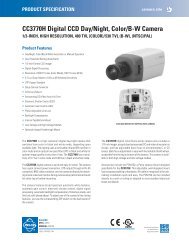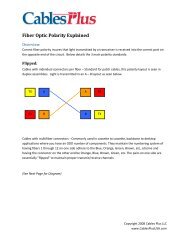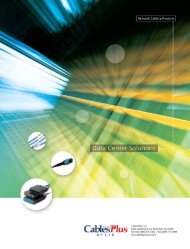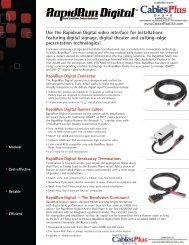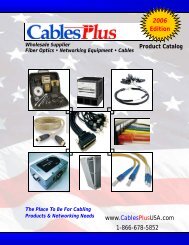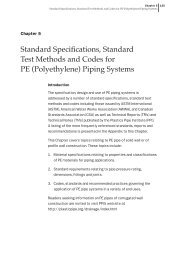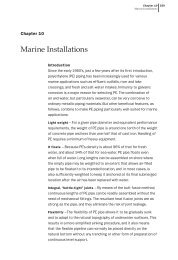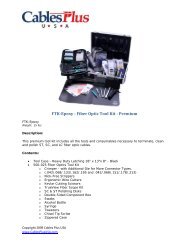Learning About Options in Fiber - Cables Plus USA
Learning About Options in Fiber - Cables Plus USA
Learning About Options in Fiber - Cables Plus USA
Create successful ePaper yourself
Turn your PDF publications into a flip-book with our unique Google optimized e-Paper software.
NUMERICAL APERTURE<br />
The numerical aperture (NA), or light-gather<strong>in</strong>g<br />
ability of a fiber, is the description of the maximum<br />
angle <strong>in</strong> which light will be accepted and propagated<br />
with<strong>in</strong> the core of the fiber. This angle of<br />
acceptance can vary depend<strong>in</strong>g upon the optical<br />
characteristics of the <strong>in</strong>dices of refraction of the<br />
core and the cladd<strong>in</strong>g.<br />
If a light ray enters the fiber at an angle which is<br />
greater than the NA or critical angle, the ray will<br />
not be reflected back <strong>in</strong>to the core. The ray will<br />
then pass <strong>in</strong>to the cladd<strong>in</strong>g becom<strong>in</strong>g a cladd<strong>in</strong>g<br />
mode, eventually to exit through the fiber surface.<br />
The NA of a fiber is important because it gives an<br />
<strong>in</strong>dication of how the fiber accepts and propagates<br />
light. A fiber with a large NA accepts light well; a<br />
fiber with a low NA requires highly directional light.<br />
<strong>Fiber</strong>s with a large NA allow rays to propagate at<br />
higher or greater angles. These rays are called<br />
higher order modes. Because these modes take<br />
longer to reach the receiver, they decrease the<br />
bandwidth capability of the fiber and will have<br />
higher attenuation.<br />
<strong>Fiber</strong>s with a lower NA, therefore, transmit lower<br />
order modes with greater bandwidth rates and lower<br />
attenuation.<br />
Manufacturers do not normally specify NA for s<strong>in</strong>glemode<br />
fibers because NA is not a critical parameter<br />
for the system designer or user. Light <strong>in</strong> a s<strong>in</strong>glemode<br />
fiber is not reflected or refracted, so it does<br />
not exit the fiber at angles. Similarly, the fiber does<br />
not accept light rays at angles with<strong>in</strong> the NA and<br />
propagate them by total <strong>in</strong>ternal reflection. Thus NA,<br />
although it can be def<strong>in</strong>ed for a s<strong>in</strong>gle-mode, is<br />
essentially mean<strong>in</strong>gless as a practical characteristic.<br />
FIBER STRENGTH<br />
One expects glass to be brittle. Yet, a fiber can be<br />
looped <strong>in</strong>to tight circles without break<strong>in</strong>g. It can also<br />
be tied <strong>in</strong>to loose knots (pull<strong>in</strong>g the knot tight will<br />
break the fiber). Tensile strength is the ability of a<br />
fiber to be stretched or pulled without break<strong>in</strong>g.<br />
The tensile strength of a fiber exceeds that of a<br />
steel filament of the same size. Further, a copper<br />
wire must have twice the diameter to have the<br />
same tensile strength as fiber.<br />
SECTION 2—FIBER-OPTIC BASICS<br />
As discussed under "Microbend Loss," the ma<strong>in</strong><br />
cause of weakness <strong>in</strong> a fiber is microscopic cracks<br />
on the surface, or flaws with<strong>in</strong> the fiber. Defects<br />
can grow, eventually caus<strong>in</strong>g the fiber to break.<br />
BEND RADIUS<br />
Even though fibers can be wrapped <strong>in</strong> circles,<br />
they have a m<strong>in</strong>imum bend radius. A sharp bend<br />
will snap the glass. Bends have two other effects:<br />
• They <strong>in</strong>crease attenuation slightly. This<br />
effect should be <strong>in</strong>tuitively clear. Bends<br />
change the angles of <strong>in</strong>cidence and<br />
reflection enough that some high-order<br />
modes are lost (similarly to microbends).<br />
• Bends decrease the tensile strength of<br />
the fiber. If pull is exerted across a bend,<br />
the fiber will fail at a lower tensile strength<br />
than if no bend were present.<br />
FIBER-OPTIC CABLE<br />
CABLE CHARACTERISTICS<br />
<strong>Fiber</strong>-optic cable is jacketed glass fiber. In order<br />
to be usable <strong>in</strong> fiber-optic systems, the somewhat<br />
fragile optical fibers are packaged <strong>in</strong>side cables<br />
for strength and protection aga<strong>in</strong>st breakage, as<br />
well as aga<strong>in</strong>st such environmental hazards as<br />
moisture, abrasion, and high temperatures.<br />
Packag<strong>in</strong>g of fiber <strong>in</strong> cable also protects the fibers<br />
from bend<strong>in</strong>g at too sharp an angle, which could<br />
result <strong>in</strong> breakage and a consequent loss of signal.<br />
Multiconductor cable is available for all designs<br />
and can have as many as 144 fibers per cable. It<br />
is noteworthy that a cable conta<strong>in</strong><strong>in</strong>g 144 fibers<br />
can be as small as .75 <strong>in</strong>ches <strong>in</strong> diameter.<br />
In addition to the superior transmission capabilities,<br />
small size, and weight advantages of fiber-optic<br />
cables, another advantage is found <strong>in</strong> the absence<br />
of electromechanical <strong>in</strong>terference. There are no<br />
metallic conductors to <strong>in</strong>duce crosstalk <strong>in</strong>to the<br />
system. Power <strong>in</strong>fluence is nonaffect<strong>in</strong>g, and security<br />
breaches of communications are (at this time)<br />
very difficult due to the complexities of tapp<strong>in</strong>g<br />
optical fiber.<br />
2-7



